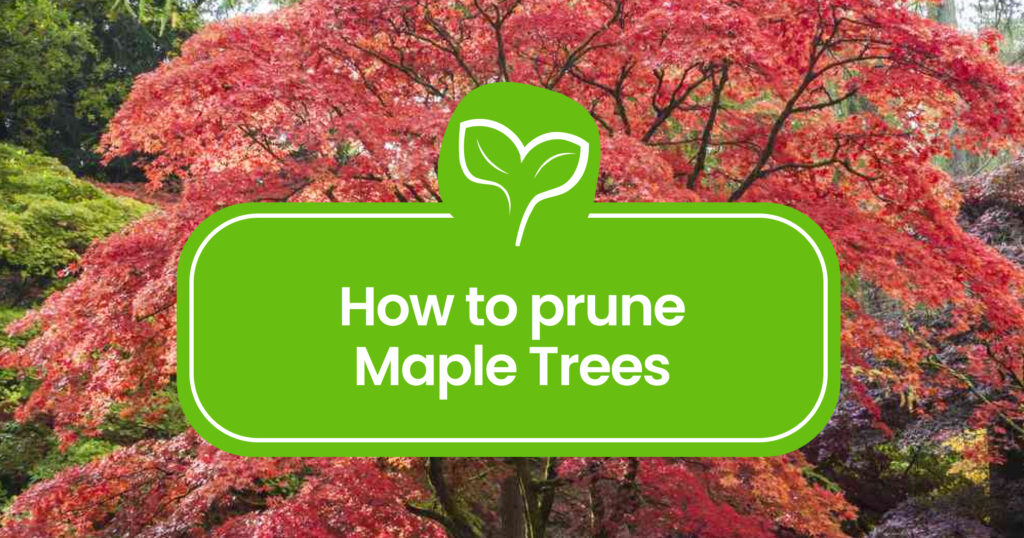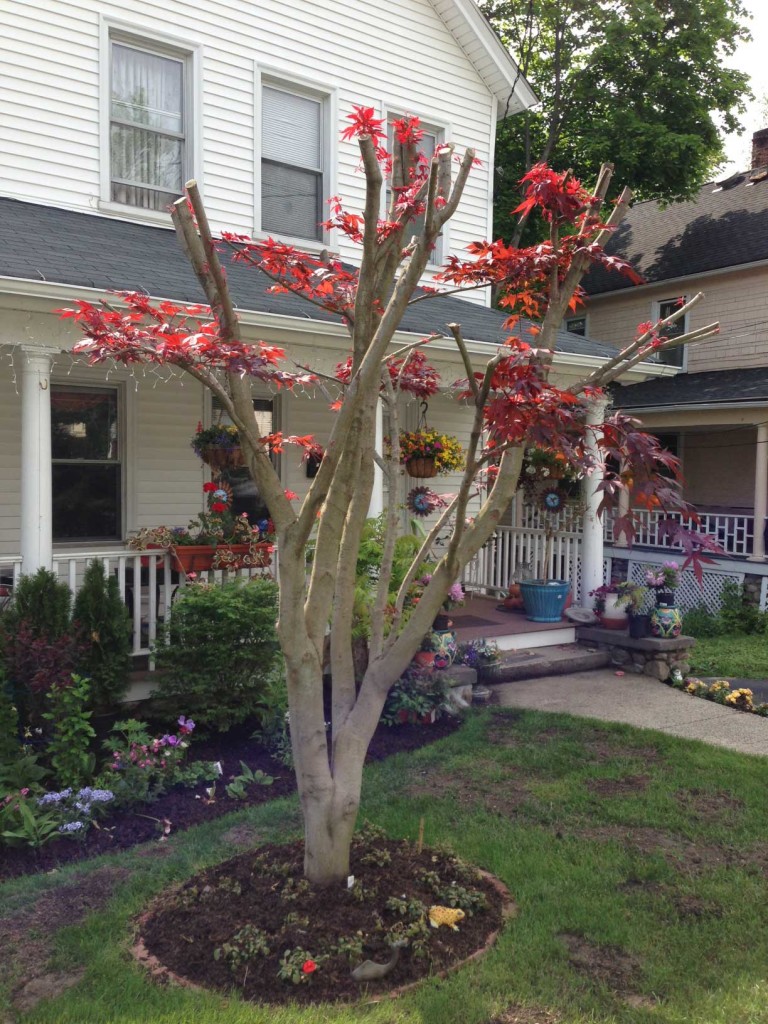
Whether you are growing a Japanese Maple, a Red Maple, or a Sugar Maple, following correct pruning guidelines and steps is a part of regular care and rewards you with a thriving tree.
Pruning maple tree branches boost the vigor and health of your tree and enhance its appearance. Read on to discover the benefits of pruning maple trees and a step-by-step guide to follow!
Maple pruning basics
Pruning is performed for several reasons and has many benefits for maple trees. Removing dead, damaged, or weak branches will reduce the risk of diseases, boost the health of a maple tree, and direct its energy toward new growth.
Thinning out overcrowded areas enhances sun penetration and airflow. And don’t forget the visual appeal of pruned maples! Maple trees don’t need pruning during the first three years of their life. You can give them light trimmings to shape them but leave it at that. After that, prune them every other year to promote growth and health.
Most trees are pruned during late winter or early spring to help prevent frost damage. However, maple trees are slightly different. Those trees ooze sap from wounds. That sap is full of nutrients, and losing an excessive amount can affect the vigor and growth of the tree. That’s why summer is the optimal time of year for pruning younger and establishing maples – the trees are slowing down growth, and wounds don’t bleed as much sap.
Pruning maple trees – tools and safety

You can prune small plants such as dill and basil with your hands and a pair of pruning shears. Maple trees understandably need a wider set of equipment.
- Pruning shears. Pruning shears, commonly called hand pruners, are scissor-like tools, perfect for cutting small branches and twigs.
- Loppers. A larger version of hand pruners. Loppers carry more cutting power and can cut through branches up to 3 inches in diameter.
- Pruning saw. Maple trees feature thick branches that are too much for loppers. That’s when you’ll reach for a pruning saw.
- Pole pruner. A Pole pruner is a tool that consists of a pruning saw or shears attached to a long pole. It helps reach high branches without a ladder.
- Ladder. Pruning a maple tree from the ground, even with the help of a pole pruner, isn’t always doable, thanks to the height of the trees.
- Puncture-resident gloves. Sturdy gloves protect your hands from thorns, sharp edges, and rough bark.
- Safety glasses. Protect your eyes from flying debris and sawdust.
It is crucial to prioritize safety when pruning large plants such as maple trees. Don’t attempt to do it without proper safety gear such as gloves, glasses, and non-slip footwear. Ensure stable ladder placement and follow proper pruning techniques. It’s advised to have a friend with you when pruning large maples.
How to prune a maple tree – different techniques and a step-by-step guide
There are several maple pruning techniques you can utilize depending on your goals. Here are some common ones.
- Crown thinning. As you can guess from the name, crown thinning means removing some branches from the tree top. That improves air circulation and sun penetration and helps to create a balanced look.
- Crown reduction. Crown reduction is used for trees grown too big and involves trimming outer branches.
- Deadwood removal. Removing dead or damaged branches maintains the tree’s health and prevents accidents such as weak branches breaking and falling.
Whether you’re reducing the crown or lifting the canopy, the guidelines for pruning stay the same.
- Gather your tools and sterilize them.
- Start by assessing the plant for signs of diseases or damage.
- Remove dead or damaged branches. Cut branches parallel to the trunk. Angled cuts lead to water collecting in the cuts and potentially leading to diseases.
- Identify branches that are crossing or rubbing against each other. Cut off the weaker-looking one.
- Thin out overcrowded areas of the tree – selectively remove smaller and weaker branches.
- Cut off low-hanging branches to encourage the tree to go straight.
- Remove suckers and water sprouts, as they can limit the growth of your maple tree.
- Select any other target branches you want to remove to achieve a desired shape and remove them.
Once you finish pruning, gather all the pruned wood and dispose of it properly – don’t leave the branches laying around. You’ll also want to assess the pruned tree and consider a wound dressing for large cuts. Keep monitoring your tree regularly to ensure it’s in good condition. Adjust care when needed.
Mistakes to avoid
Understanding maple trees and their pruning needs is essential for avoiding mistakes such as over-pruning, pruning at the wrong time, and topping your tree.

- Pruning too much of the tree can put it under stress and slow its growth instead of encouraging it. There is no need to prune maples excessively – stick to removing damaged and diseased foliage, crossing branches, and thinning out overgrown areas.
- Adjusting the pruning time according to your climate and specific tree is a good idea for the best results. Established and mature maple trees can handle pruning while dormant, like most trees – young trees benefit more from summer pruning to prevent an excessive loss of sap.
- Topping (see the picture) is another common mistake and one of the worst things you could do. The practice involves cutting the tree’s main trunk to reduce the size of the tree. Avoid doing that at all costs, as it weakens the tree, leaves it vulnerable to pests and diseases, and decreases its ability to photosynthesize.
Pruning and aesthetics
Pruning has the potential to enhance any maple’s appearance. The simple practice allows you to create a balanced and attractive structure and achieve the desired form. It helps sunlight filter through the branches, emphasizing the tree’s natural beauty. Here are some tips when doing it for aesthetic purposes.
- Respect the natural growth pattern and branch structure of your maple tree. Work with what you have and enhance the appeal of your tree instead of trying to get the tree to grow in an unnatural pattern.
- Be patient when shaping your tree. Do it gradually over several years if needed. A slow approach leads to brilliant results – over-pruning does not!
- Maintain balance by trimming a maple all around – giving more attention to one side of the tree than the other leads to an unbalanced and weird look.
- And last but not least, monitor the tree as it grows and adjust the care and pruning practices when needed.
To sum it up
Maples don’t need excessive pruning or even annual pruning. However, that doesn’t mean you should never trim them. Getting the timing right and following proper pruning guidelines will boost the health and longevity of your maple tree and leave you with a gorgeous plant.
Pruning maple trees doesn’t have to be challenging – follow the tips and pruning guide we shared!
Frequently Asked Questions
Start by removing dead or damaged parts of the tree. Additionally, address crossing and rubbing branches and thin out overgrown areas.
When do you prune maple trees?
The best time for pruning maples is in early to late summer. Pruning maples during summer, when their growth is slowing down, prevents them from losing too much sap.
How to prune young maple trees?
Don’t prune maple trees for the first three years of their life. After that, you can prune them every other year. Remove damaged branches, thin out overgrown areas, and use selective pruning for shaping the tree. Avoid excessive pruning.
What limbs do I trim from a maple?
Cut off dead, damaged, crossing, or rubbing branches. Additionally, remove low-hanging branches.
When can you not trim a Japanese Maple?
Established Japanese Maple can handle pruning at any point of the year if needed. However, younger maples are more prone to sap loss during pruning – don’t prune them until summertime.
How hard can you prune a Japanese Maple?
Avoid excessive pruning unless doing it for rejuvenating purposes. Don’t cut off more than a third of the tree.
